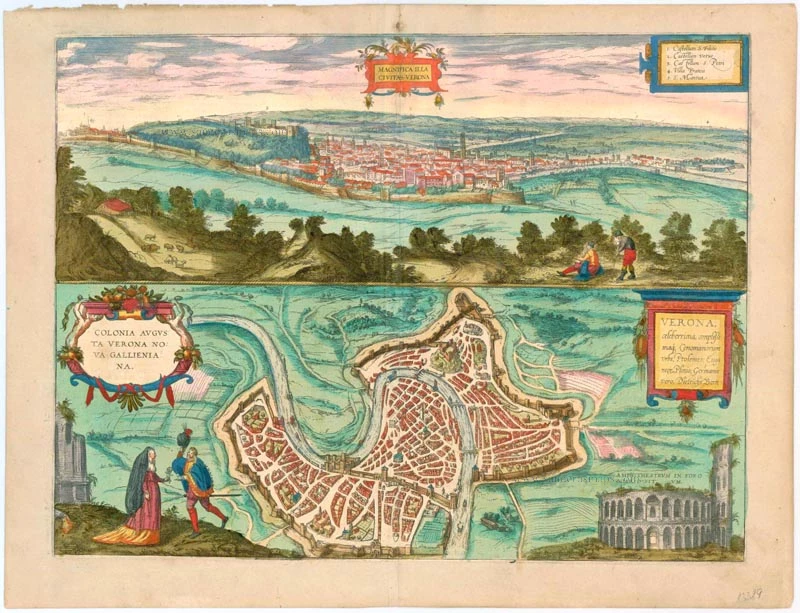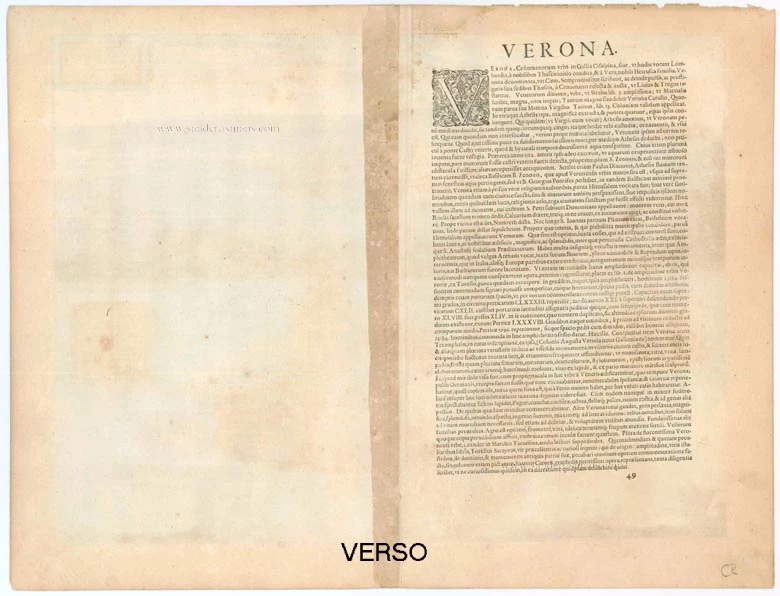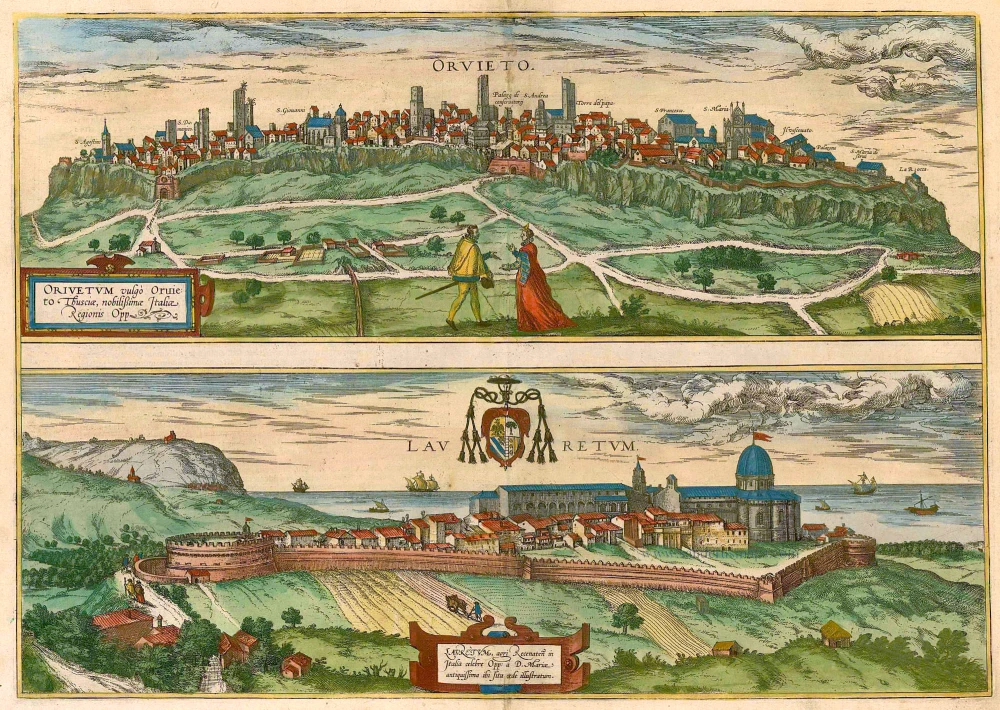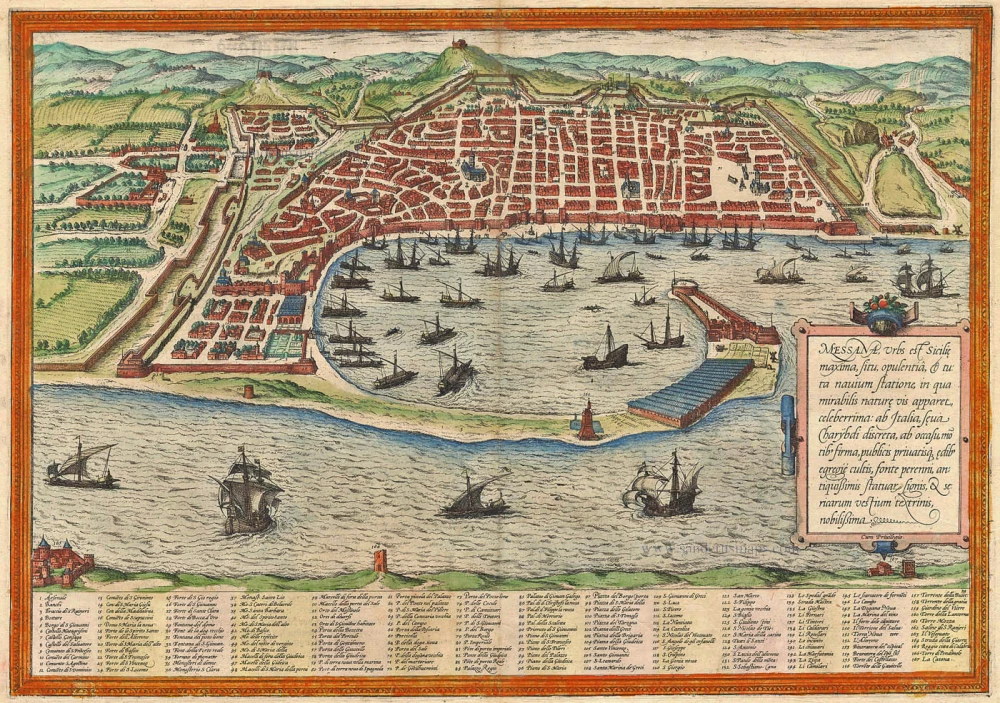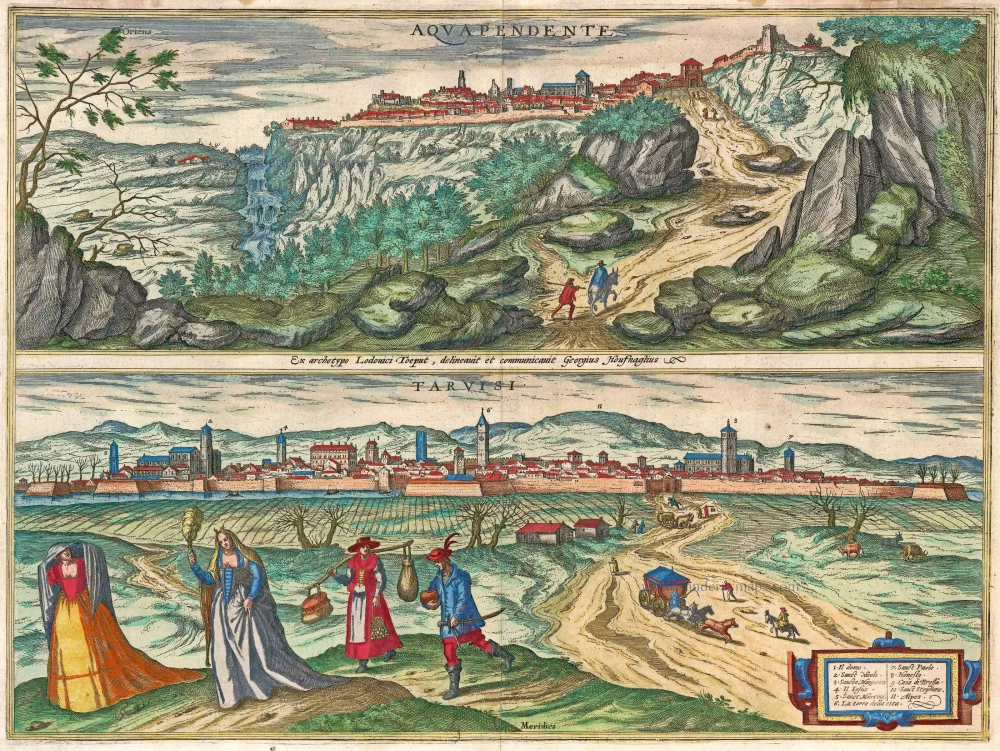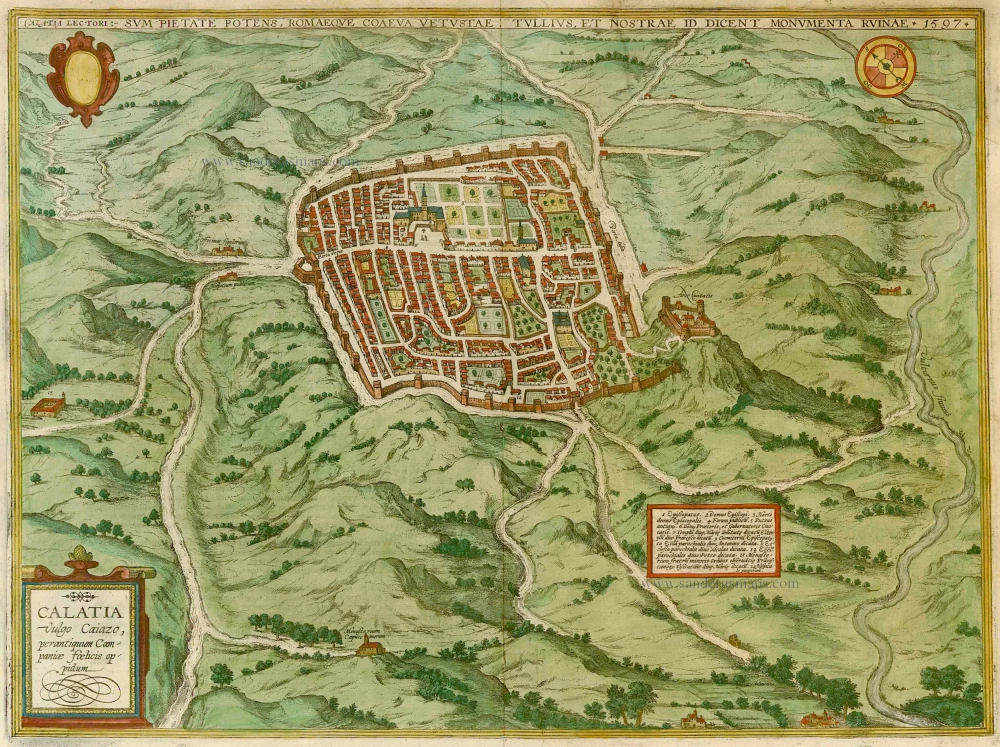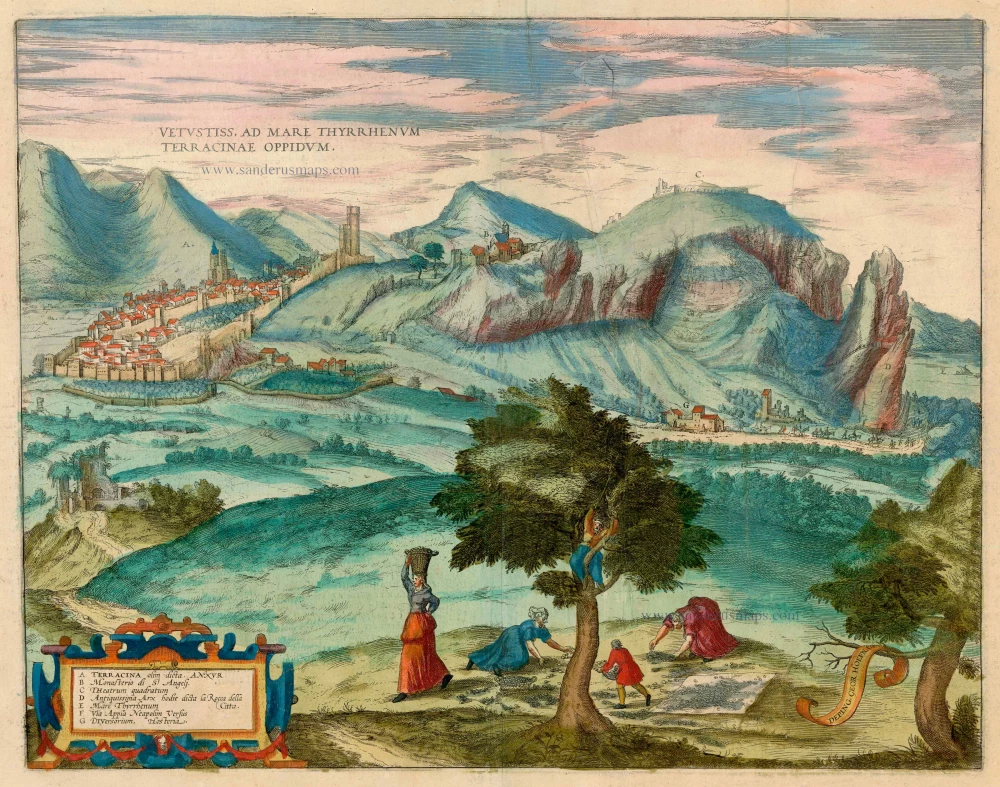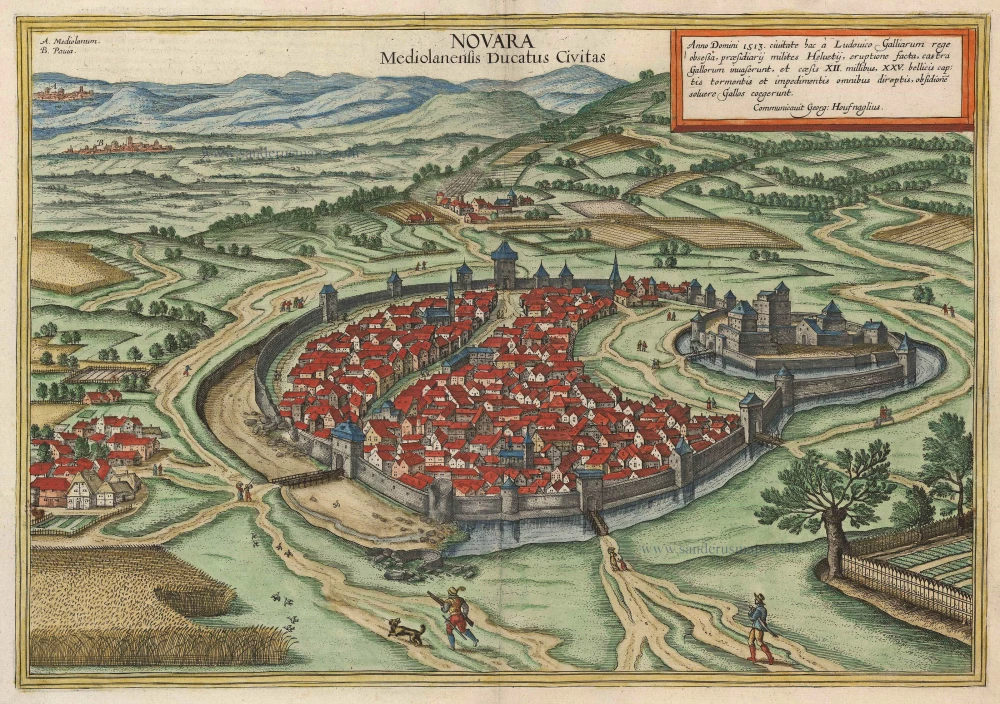Old, antique map - Bird's-eye view and plan of Verona by Braun and Hogenberg. 1581-88
TRANSLATION OF CARTOUCHE BOTTOM RIGHT: Verona, most famous and most important city of the Cenomani according to Ptolemy, of the Euganei according to Pliny; Dietrich's Bern to the Germans. COMMENTARY BY BRAUN (on verso): "It has many ancient monuments, including a round theatre that is called the Arena; it stands on the cattle market and is a wonderful and very large structure, which despite its age has not fallen half into ruins or been destroyed by the attacks of foreign peoples, but has survived intact to an extent rarely found in Italy or anywhere else in Europe. In order that those who have never seen the like may better understand the width of his unbelievably large arena, I would like to quote further from Torelli's second volume: it has been determined that 23,184 people can be comfortably seated on the tiered steps of the theatre." Verona is illustrated twice on the same page. The upper view shows the city from a slight elevation from the north, looking across the Adige, while the bird's-eye perspective below offers a plan view of the city from the south. The upper prospect emphasizes the Castel San Pietro (3, left), expanded by the Visconti in the 15th century, and the city's many family and defensive towers. The lower illustration includes a detailed view of the amphitheatre, built around the same time as the Coliseum in Rome (c. AD 50). This Arena, which holds some 22,000 people, is today the venue for the annual Verona Opera Festival. The city became a Roman colony in 89 BC and in AD 489 the residence of Theodoric the Great, king of the Ostrogots, who inspired the figure of Dietrich von Bern (Bern signifying "Verona") in German legend. For many Verona is renowned as the fictional setting of William Shakespeare's famous tragedy Romeo and Juliet . (Taschen)
Braun G. & Hogenberg F. and the Civitates Orbis Terrarum.
The Civitates Orbis Terrarum, also known as the 'Braun & Hogenberg', is a six-volume town atlas and the most excellent book of town views and plans ever published: 363 engravings, sometimes beautifully coloured. It was one of the best-selling works in the last quarter of the 16th century. Georg Braun, a skilled writer, wrote the text accompanying the plans and views on the verso. Many plates were engraved after the original drawings of a professional artist, Joris Hoefnagel (1542-1600). The first volume was published in Latin in 1572 and the sixth in 1617. Frans Hogenberg, a talented engraver, created the tables for volumes I through IV, and Simon van den Neuwel made those for volumes V and VI. Other contributors were cartographers Daniel Freese and Heinrich Rantzau, who provided valuable geographical information. Works by Jacob van Deventer, Sebastian Münster, and Johannes Stumpf were also used as references. Translations appeared in German and French, making the atlas accessible to a broader audience.
Since its original publication of volume 1 in 1572, the Civitates Orbis Terrarum has left an indelible mark on the history of cartography. Seven more editions followed the first volume in 1575, 1577, 1582, 1588, 1593, 1599, and 1612. Vol.2, initially released in 1575, saw subsequent editions in 1597 and 1612. The subsequent volumes, each a treasure trove of historical insights, graced the world in 1581, 1588, 1593, 1599, and 1606. The German translation of the first volume, a testament to its widespread appeal, debuted in 1574, followed by the French edition in 1575.
Several printers were involved: Theodor Graminaeus, Heinrich von Aich, Gottfried von Kempen, Johannis Sinniger, Bertram Buchholtz, and Peter von Brachel, all of whom worked in Cologne.
Georg Braun (1541-1622)
Georg Braun, the author of the text accompanying the plans and views in the Civitates Orbis Terrarum, was born in Cologne in 1541. After his studies in Cologne, he entered the Jesuit Order as a novice, indicating his commitment to learning and intellectual pursuits. In 1561, he obtained his bachelor's degree; in 1562, he received his Magister Artium, further demonstrating his academic achievements. Although he left the Jesuit Order, he continued his studies in theology, gaining a licentiate in theology. His theological background likely influenced the content and tone of the text in the Civitates Orbis Terrarum, adding a unique perspective to the work.
Frans Hogenberg (1535-1590)
Frans Hogenberg was a Flemish and German painter, engraver, and mapmaker. He was born in Mechelen as the son of Nicolaas Hogenberg.
By the end of the 1560s, Frans Hogenberg was employed upon Abraham Ortelius's Theatrum Orbis Terrarum, published in 1570; he is named an engraver of numerous maps. In 1568, he was banned from Antwerp by the Duke of Alva and travelled to London, where he stayed a few years before emigrating to Cologne. He immediately embarked on his two most important works, the Civitates, published in 1572 and the Geschichtsblätter, which appeared in several series from 1569 until about 1587.
Thanks to large-scale projects like the Geschichtsblätter and the Civitates, Hogenberg's social circumstances improved with each passing year. He died as a wealthy man in Cologne in 1590.
Magnifica Illa Civitas Verona [on sheet with] Colonia Augusta Verona Nova Galieniana Verona, Celeberrima, Amplissimaque Cenomanorum Urbs, Ptolemaeo.
Item Number: 23329 Authenticity Guarantee
Category: Antique maps > Europe > Italy - Cities
Antique map - Bird's-eye view and plan of Verona by Braun and Hogenberg. Key to locations.
TRANSLATION OF CARTOUCHE BOTTOM RIGHT: Verona, most famous and most important city of the Cenomani according to Ptolemy, of the Euganei according to Pliny; Dietrich's Bern to the Germans.
COMMENTARY BY BRAUN (on verso): "It has many ancient monuments, including a round theatre that is called the Arena; it stands on the cattle market and is a wonderful and very large structure, which despite its age has not fallen half into ruins or been destroyed by the attacks of foreign peoples, but has survived intact to an extent rarely found in Italy or anywhere else in Europe. In order that those who have never seen the like may better understand the width of his unbelievably large arena, I would like to quote further from Torelli's second volume: it has been determined that 23,184 people can be comfortably seated on the tiered steps of the theatre."
Verona is illustrated twice on the same page. The upper view shows the city from a slight elevation from the north, looking across the Adige, while the bird's-eye perspective below offers a plan view of the city from the south. The upper prospect emphasizes the Castel San Pietro (3, left), expanded by the Visconti in the 15th century, and the city's many family and defensive towers. The lower illustration includes a detailed view of the amphitheatre, built around the same time as the Coliseum in Rome (c. AD 50). This Arena, which holds some 22,000 people, is today the venue for the annual Verona Opera Festival. The city became a Roman colony in 89 BC and in AD 489 the residence of Theodoric the Great, king of the Ostrogots, who inspired the figure of Dietrich von Bern (Bern signifying "Verona") in German legend. For many Verona is renowned as the fictional setting of William Shakespeare's famous tragedy Romeo and Juliet . (Taschen)
Copper engraving
Size: 36 x 47cm (14 x 18.3 inches)
Verso text: Latin
Condition: Superb old colour, excellent.
Condition Rating: A+
References: Van der Krogt 4, 4659, State 1; Taschen, Braun and Hogenberg, p.256
From: Civitates Orbis Terrarum. . Liber tertius. Köln, G. Kempen, 1581-88. (Koeman, B&H3)
TRANSLATION OF CARTOUCHE BOTTOM RIGHT: Verona, most famous and most important city of the Cenomani according to Ptolemy, of the Euganei according to Pliny; Dietrich's Bern to the Germans. COMMENTARY BY BRAUN (on verso): "It has many ancient monuments, including a round theatre that is called the Arena; it stands on the cattle market and is a wonderful and very large structure, which despite its age has not fallen half into ruins or been destroyed by the attacks of foreign peoples, but has survived intact to an extent rarely found in Italy or anywhere else in Europe. In order that those who have never seen the like may better understand the width of his unbelievably large arena, I would like to quote further from Torelli's second volume: it has been determined that 23,184 people can be comfortably seated on the tiered steps of the theatre." Verona is illustrated twice on the same page. The upper view shows the city from a slight elevation from the north, looking across the Adige, while the bird's-eye perspective below offers a plan view of the city from the south. The upper prospect emphasizes the Castel San Pietro (3, left), expanded by the Visconti in the 15th century, and the city's many family and defensive towers. The lower illustration includes a detailed view of the amphitheatre, built around the same time as the Coliseum in Rome (c. AD 50). This Arena, which holds some 22,000 people, is today the venue for the annual Verona Opera Festival. The city became a Roman colony in 89 BC and in AD 489 the residence of Theodoric the Great, king of the Ostrogots, who inspired the figure of Dietrich von Bern (Bern signifying "Verona") in German legend. For many Verona is renowned as the fictional setting of William Shakespeare's famous tragedy Romeo and Juliet . (Taschen)
Braun G. & Hogenberg F. and the Civitates Orbis Terrarum.
The Civitates Orbis Terrarum, also known as the 'Braun & Hogenberg', is a six-volume town atlas and the most excellent book of town views and plans ever published: 363 engravings, sometimes beautifully coloured. It was one of the best-selling works in the last quarter of the 16th century. Georg Braun, a skilled writer, wrote the text accompanying the plans and views on the verso. Many plates were engraved after the original drawings of a professional artist, Joris Hoefnagel (1542-1600). The first volume was published in Latin in 1572 and the sixth in 1617. Frans Hogenberg, a talented engraver, created the tables for volumes I through IV, and Simon van den Neuwel made those for volumes V and VI. Other contributors were cartographers Daniel Freese and Heinrich Rantzau, who provided valuable geographical information. Works by Jacob van Deventer, Sebastian Münster, and Johannes Stumpf were also used as references. Translations appeared in German and French, making the atlas accessible to a broader audience.
Since its original publication of volume 1 in 1572, the Civitates Orbis Terrarum has left an indelible mark on the history of cartography. Seven more editions followed the first volume in 1575, 1577, 1582, 1588, 1593, 1599, and 1612. Vol.2, initially released in 1575, saw subsequent editions in 1597 and 1612. The subsequent volumes, each a treasure trove of historical insights, graced the world in 1581, 1588, 1593, 1599, and 1606. The German translation of the first volume, a testament to its widespread appeal, debuted in 1574, followed by the French edition in 1575.
Several printers were involved: Theodor Graminaeus, Heinrich von Aich, Gottfried von Kempen, Johannis Sinniger, Bertram Buchholtz, and Peter von Brachel, all of whom worked in Cologne.
Georg Braun (1541-1622)
Georg Braun, the author of the text accompanying the plans and views in the Civitates Orbis Terrarum, was born in Cologne in 1541. After his studies in Cologne, he entered the Jesuit Order as a novice, indicating his commitment to learning and intellectual pursuits. In 1561, he obtained his bachelor's degree; in 1562, he received his Magister Artium, further demonstrating his academic achievements. Although he left the Jesuit Order, he continued his studies in theology, gaining a licentiate in theology. His theological background likely influenced the content and tone of the text in the Civitates Orbis Terrarum, adding a unique perspective to the work.
Frans Hogenberg (1535-1590)
Frans Hogenberg was a Flemish and German painter, engraver, and mapmaker. He was born in Mechelen as the son of Nicolaas Hogenberg.
By the end of the 1560s, Frans Hogenberg was employed upon Abraham Ortelius's Theatrum Orbis Terrarum, published in 1570; he is named an engraver of numerous maps. In 1568, he was banned from Antwerp by the Duke of Alva and travelled to London, where he stayed a few years before emigrating to Cologne. He immediately embarked on his two most important works, the Civitates, published in 1572 and the Geschichtsblätter, which appeared in several series from 1569 until about 1587.
Thanks to large-scale projects like the Geschichtsblätter and the Civitates, Hogenberg's social circumstances improved with each passing year. He died as a wealthy man in Cologne in 1590.

![Magnifica Illa Civitas Verona [on sheet with] Colonia Augusta Verona Nova Galieniana Verona, Celeberrima, Amplissimaque Cenomanorum Urbs, Ptolemaeo.](https://sanderusmaps.com/assets/RESIZED/thumb_m32004.jpg)

